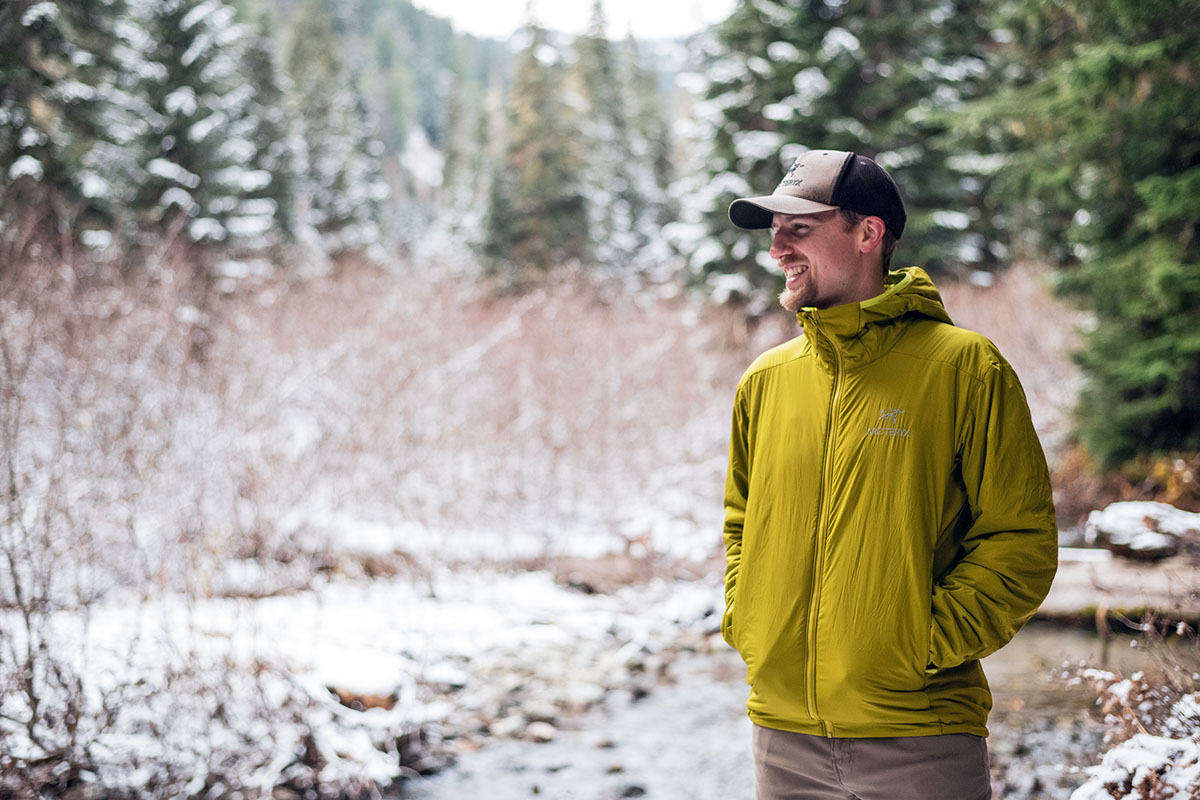
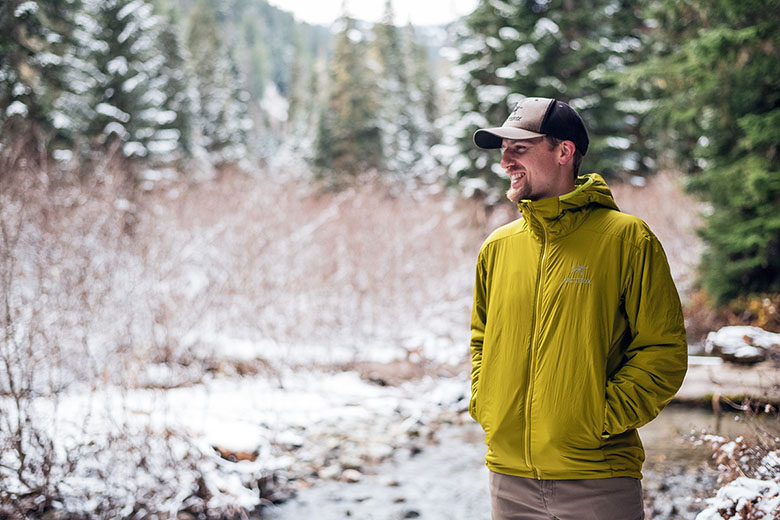
Switchback Travel (Jason Hummel)
Price: $300
Weight: 13.1 oz. (men's)
Insulation: Coreloft Compact (60g)
What we like: Standout combination of comfort, mobility, warmth, and good looks.
What we don’t: Pricey and breathability could be better.
See the Men's Arc'teryx Atom Hoody See the Women's Atom Hoody
Arc’teryx’s Atom is a legend. This popular synthetic piece crosses over between daily wear and backcountry use as well as anything on the market thanks to its truly impressive balance of warmth, comfort, and styling. We put the past-generation Atom LT—which has since been renamed the Atom Hoody—to the test in a range of shoulder-season and winter-like conditions. The verdict: It’s as versatile as ever, but tweaks to the fit (it’s a little longer than prior generations) and improved durability should only widen its appeal. Below we break down the Atom LT’s performance. To see how it stacks up to the competition, see our articles on the best synthetic jackets and best midlayers.
Editor’s note: We tested the past-generation Atom LT Hoody for this review, which has since been replaced by the Atom Hoody. Changes were minor, including a 0.1-ounce drop in weight and a stronger focus on sustainability. The new Atom also costs $41 more than the prior model. We’ve outlined the changes where applicable in the text below and will update this write-up once we test the latest Atom.
The Arc’teryx Atom LT Hoody—along with its successor, the Atom Hoody—has synthetic insulation, so it won’t rival down fill in terms of warmth or packability. Having said that, this jacket makes a really nice fall and spring outer layer and also works great as a midlayer for snowsports and in frigid temperatures. It’s filled with 60-gram (g) Coreloft Compact insulation everywhere but the side panels, which are a stretchy midweight fleece. This low-profile design puts it on par with other leading synthetics like Patagonia’s Nano Puff and The North Face’s ThermoBall. In addition, its weather-resistant shell does a nice job cutting wind, and the tall collar, adjustable hem, and fantastic hood (more on this below) help when you need to hunker down in cold temps.
In terms of warmth, the Atom LT was comfortable down to about 40 degrees Fahrenheit without much in the way of layering underneath. It certainly can go lower with a warm baselayer or if you’re on the move—it was an ideal outer layer on a hike with temperatures hovering in the high 20s Fahrenheit. But for static use, such as sitting around camp when the sun goes down, we’re switching to a down jacket or adding a shell overtop. For a similar design with more warmth, Arc’teryx also makes the Atom Heavyweight Hoody, which ditches the stretch side panels and includes more substantial 120g Coreloft around the body and slightly less in the underarms (80g) and hood (60g).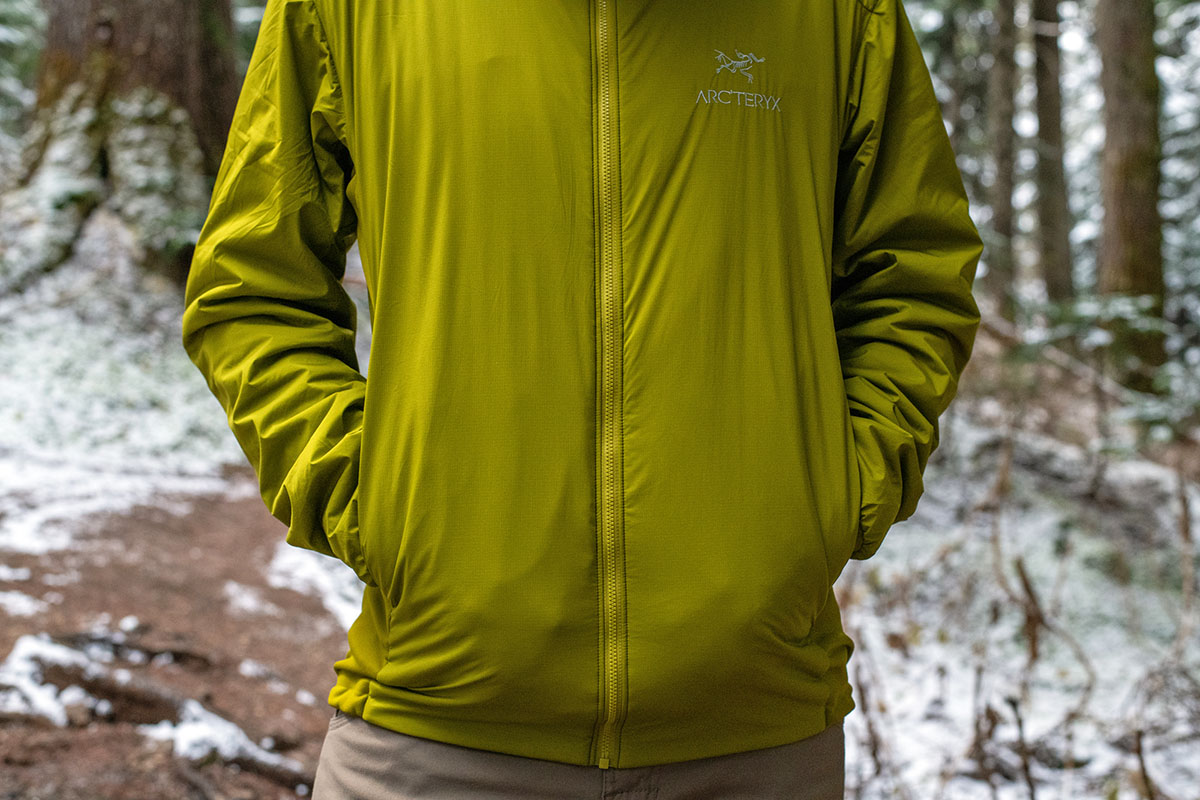
Featuring a weather-resistant shell, synthetic insulation, and excellent coverage from its collar and adjustable hood, the Arc'teryx Atom does a nice job in light to moderate precipitation and wind. The Tyono face fabric feels slightly more substantial than other leading synthetics we’ve worn—including Patagonia’s popular Nano-Air—and it’s finished with a DWR treatment that effectively beads up water and snow. Fleece isn't a great wind blocker, so the side panels will let in strong gusts, but its hard-face exterior repels moisture effectively. To be clear, the jacket will start to soak up water in extended rainfall, so it shouldn’t take the place of a waterproof rain jacket or hardshell. But if you do happen to get caught in a surprise storm, the jacket can hold its own for a short period of time. And if water happens to get into the insulation, the good news is that the Coreloft fill will continue to provide warmth (something duck and goose down will not do).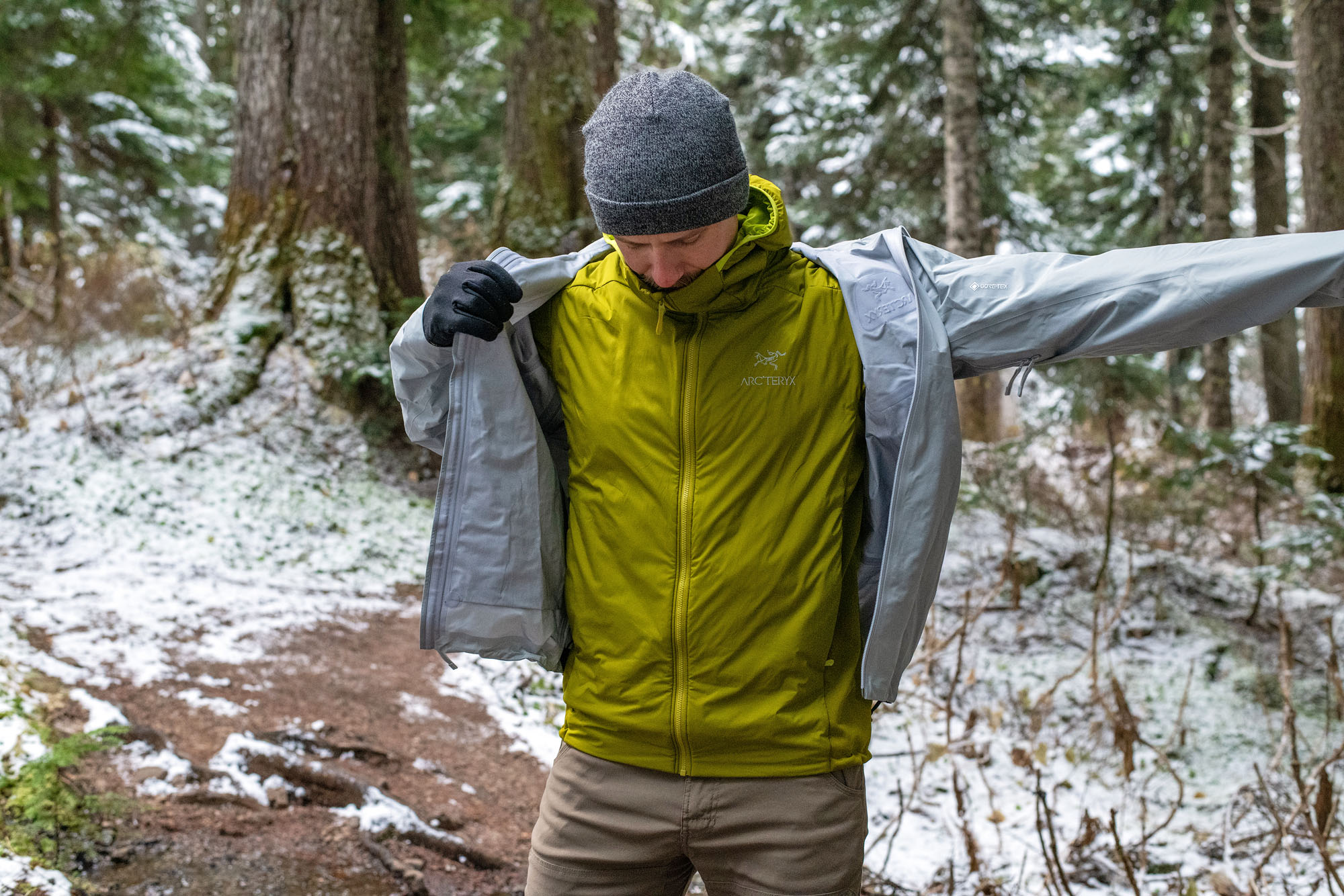
One of the compromises of the Atom’s efficient warmth and decent weather resistance is breathability. Unlike active-insulation jackets like the Patagonia Nano-Air, Black Diamond First Light Stretch, and even Arc’teryx’s own Proton, the Atom runs fairly warm during high-output sports like ski touring. Its face fabric and lining do a good job trapping heat, and while the fleece side panels do help with releasing some hot air, overall ventilation is solidly middle-of-the-road. That being said, we’ve found the jacket excels for moderately strenuous activities like hiking and downhill skiing (it’s a near-perfect midlayer in this case), and its warmth is a benefit if the temperatures are particularly cold (we’ve used it for cross-country skiing in the Midwest). In the end, those looking for a high-performance piece will be better off with the Proton, but the Atom is the more versatile design if you plan to wear it casually and around town.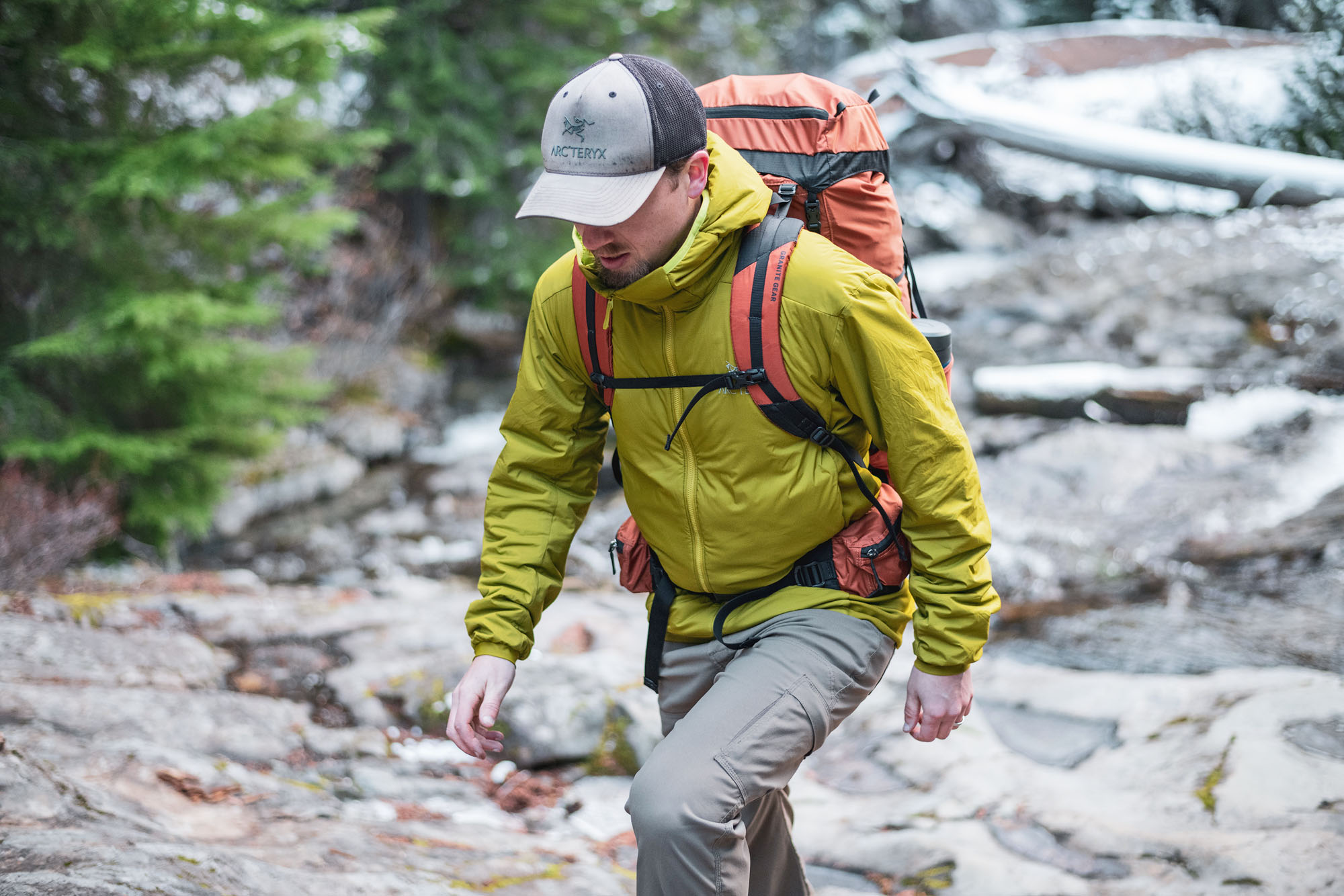
The Atom LT checked in at 12.9 ounces on my scale for a men’s medium, which is 0.3 ounces less than its listed weight (note: The new Atom Hoody is ever-so-slightly lighter at 13.1 oz.) and perfectly reasonable to haul around in a pack. For comparison, the Patagonia Nano-Air Hoody (14.1 oz.) and The North Face Summit Series Casaval Hoodie (12.6 oz.) are fairly similar in weight and breathe better but offer less warmth and weather protection. Some down mimickers, like the Patagonia Micro Puff Hoody (10.5 oz.) and Outdoor Research SuperStrand LT Hoodie (10.9 oz.), are considerably lighter but also less durable and versatile. Another popular all-rounder, the Patagonia Nano Puff Hoody, weighs almost exactly the same at 12.8 ounces. Of course, you can cut weight by going with a true down jacket, many of which clock in around 10 ounces or less, but you do compromise in terms of temperature regulation, wet-weather performance, and cost.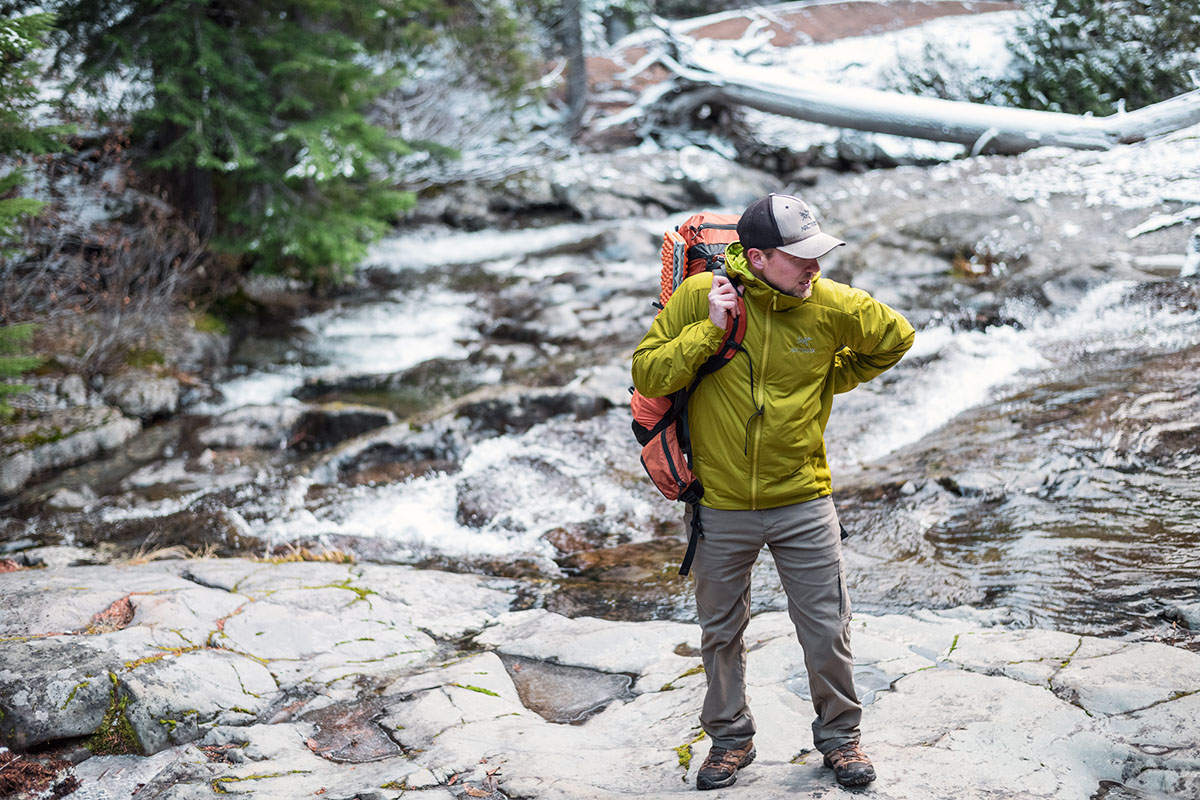
Unfortunately, the Atom doesn’t come with a stuff sack, nor is it designed to fit into one of its own pockets. We’ve always considered this an interesting choice, since many users wind up rolling the jacket into its hood to toss into a backpack or suitcase for travel. When stuffed down this way and with the hood cinched, my men’s medium is roughly the size of an American football (squeezing it in a bag will make it a little smaller). That’s a far cry from the truly tiny SuperStrand LT and down-insulated alternatives like Arc’teryx’s own Cerium, but it's perfectly serviceable for day hikes and typical backcountry uses.
Of all of the categories in this review, comfort is the area where the Arc'teryx Atom excels most. Simply put, we never want to take this jacket off. You can wear it hiking or climbing and then to the grocery store or bar afterward, all without missing a beat. The interior lining is soft and smooth to the touch, the stretchy sides and relatively athletic cut give it fantastic mobility, and the Coreloft insulation creates a pillow-like barrier from the outside world. Tack on thoughtful touches like a fleece-like lining inside the hand pockets (for the back of your hands) and smooth cuffs, and the Atom is one of the coziest and most versatile jackets we’ve ever owned.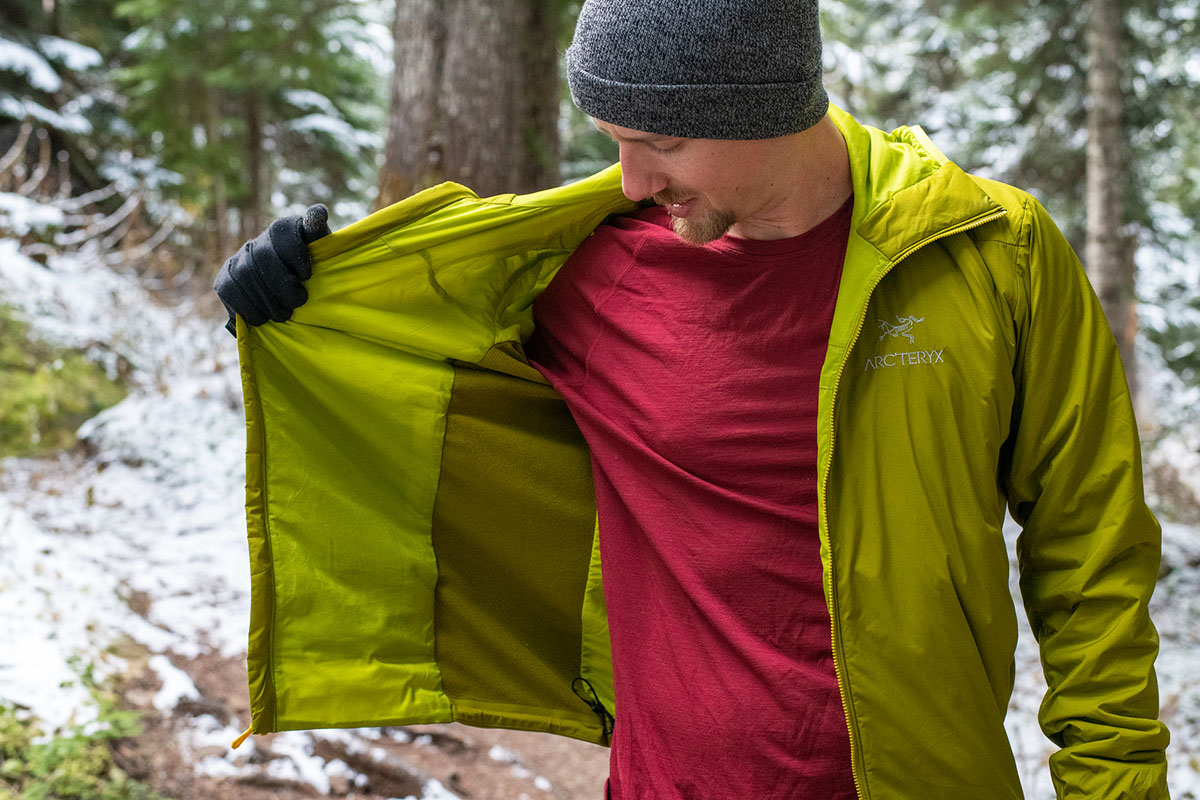
Build quality is rarely a concern with Arc'teryx products—it’s a hallmark of the brand and a key reason people are willing to pay a premium for their gear—and this held true with the Atom LT Hoody. Everything from the stitching on the logo to the soft-touch lining and smooth exterior have a high-end look and feel. The main zipper is very confidence-inspiring with its large teeth, and a unique “no slip” design at the top of the collar keeps it from unzipping when on the move. Further, the cinch cord and plastic hardware for the hem and hood adjustments all appear well made.
It's worth noting that the Atom LT tested here featured some light updates to the 20D Tyono face fabric (and the latest Atom Hoody uses the same material). In testing, the shell did feel a little more substantial than prior versions, but the differences were minor, and we still recommend being careful around sharp equipment. The good news is that all iterations of the jacket we’ve tested over the years have proven to be quite hardwearing. Arc’teryx also shifted to a new variation of their Coreloft insulation for the fall 2020 update, which is designed to hold its shape better over time. Following a few seasons of testing, we had no durability concerns with the Atom LT (and the latest Atom should fare similarly well given its nearly identical construction).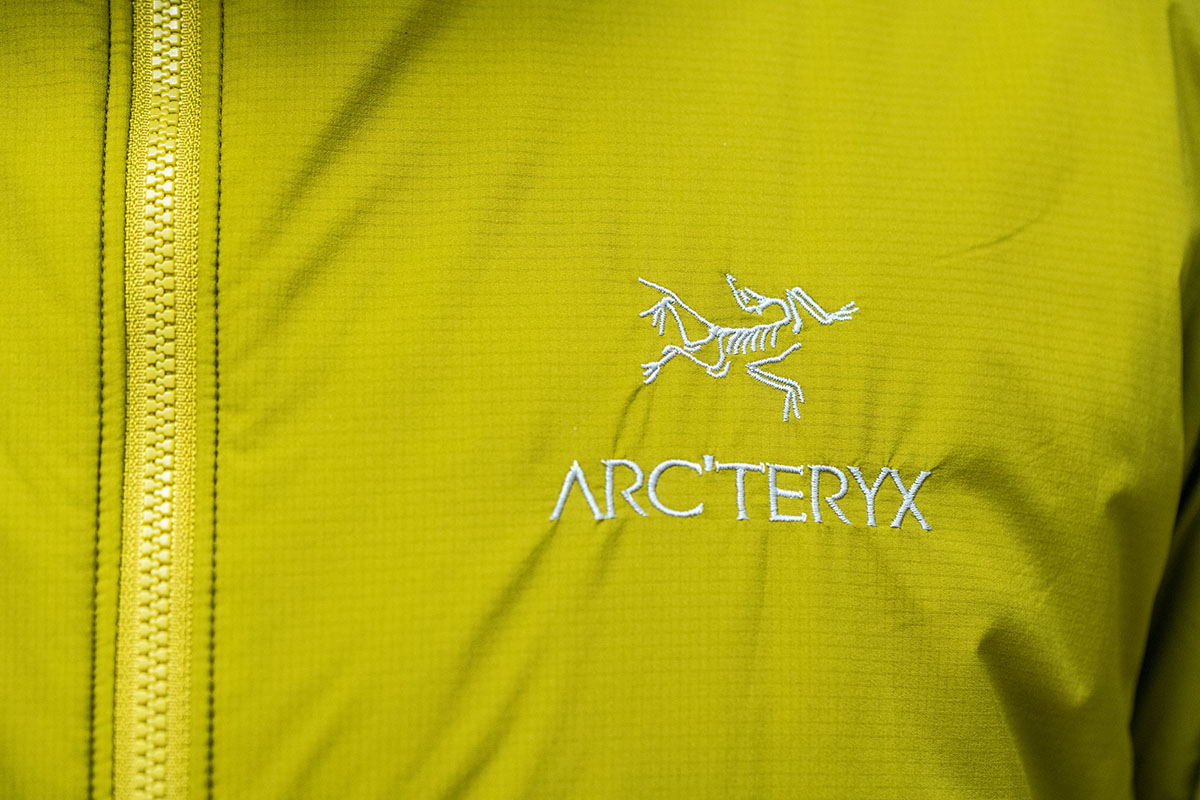
We tested the Atom LT Hoody for this review, which also came in a non-hooded version (note: The current Atom lineup includes both hooded and non-hooded styles, too). In general, we prefer hooded jackets for everyday wear—the hood comes in handy for walking around the neighborhood on chilly days, and definitely for hiking or sitting around the campfire. Moreover, Arc’teryx does hoods right: The Atom LT features a cinch around back that tightens evenly around the sides and top of the head, plus its secure design holds everything in place even in strong winds. In addition, the protection along the sides of the face is excellent, and its small brim is a great feature for providing structure and to help keep moisture from dripping down. You also get the same 60g Coreloft Compact insulation in the hood for some nice added warmth.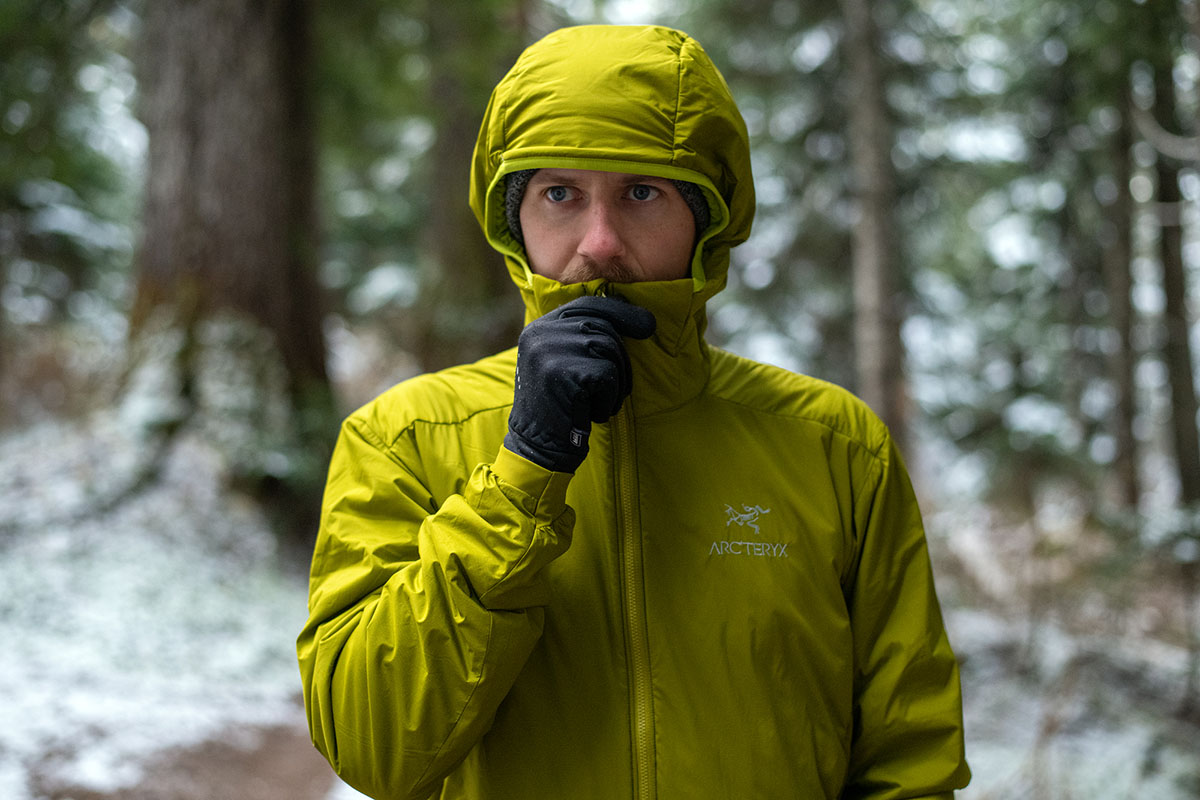
In terms of organization, the Atom includes two standard hand pockets and an interior zippered chest pocket. The hand pockets are a useful size—they’re large enough to fit gloves—and the fleece-like lining feels great on the back of your hands. They do sit fairly low, so access to the pockets will be mostly blocked if you plan to wear the jacket with a backpack or harness (the upside is they’re at a natural position for stuffing your hands in to protect them from the cold). And along the interior, the chest pocket sits on your left side and is plenty big to fit items like a wallet or modern cell phone. As we mentioned above, we’d prefer they included a stuff pocket for compressing the jacket, but otherwise we have zero storage-related complaints.
Arc’teryx updated the fit with the Atom LT model we tested for this review, with a little more length at the front and back (note: The latest Atom Hoody shares a similar fit but with additional room in the midsection for added mobility). It’s still a great length for wearing as a midlayer, but the extended dimensions will help for taller folks who have had sizing issues in the past (from our measurements, it’s about 0.5 in. longer at the back compared to the prior model). The cut of the jacket remains on the trim end, which is great for those who like an athletic fit. We did find that the shape around the waist is a little more accommodating, but otherwise it’s quite familiar (which is a good thing). At 5’9” and 155 pounds, I opted for my standard men’s medium and found it to be pretty much perfect.
As we mentioned previously, this review covers the past-generation Atom LT, and the latest Atom collection comprises similar styles but with a few new additions. In addition to the men's hooded jacket, the Atom also comes in a women’s hoody that clocks in at 10.9 ounces, costs the same at $300, and has a nearly identical build. In terms of other versions, the Atom is available in a non-hooded jacket that’s slightly lighter at 11.6 ounces and cheaper at $280, as well as a vest that weighs 8.1 ounces and costs $200. Final options in the lineup include a warmer Heavyweight version (which we outline below), Lightweight (women’s) and SL (men’s) variations of the hoody and vest styles, a women’s crew-neck pullover, and a women’s shirt/jacket hybrid called the Atom Shacket.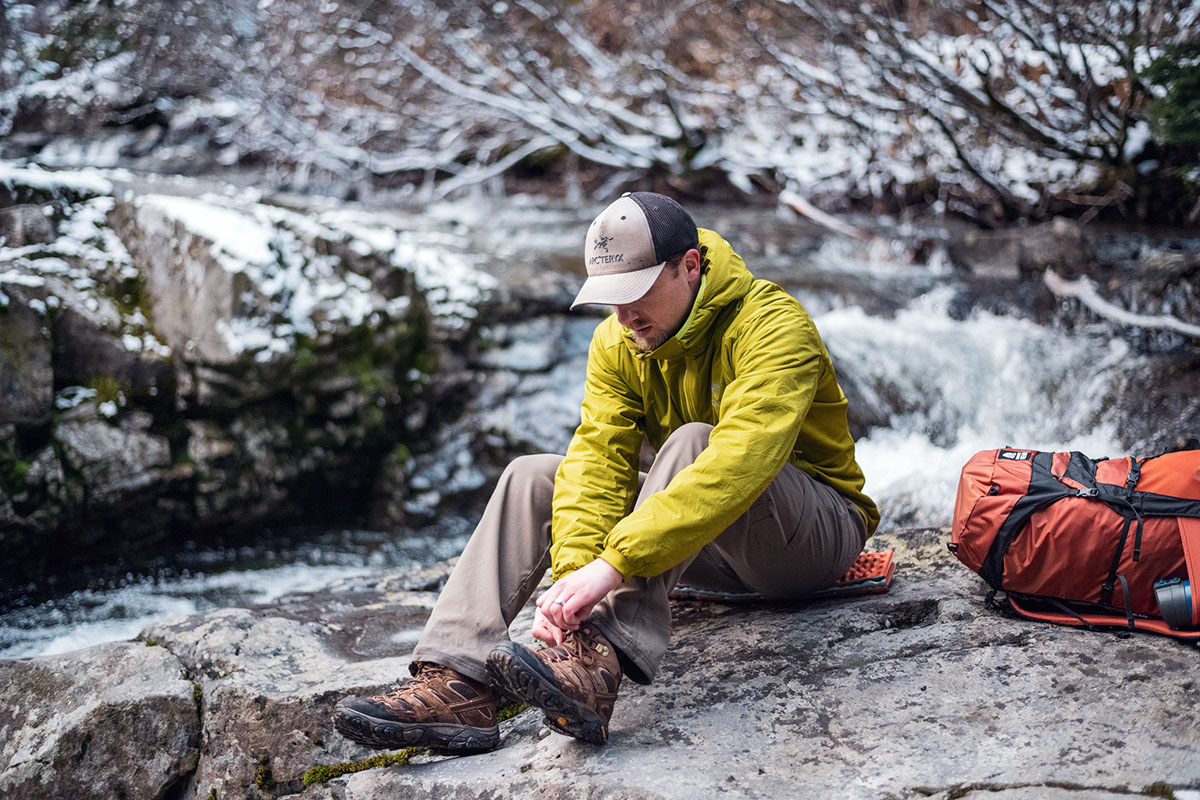
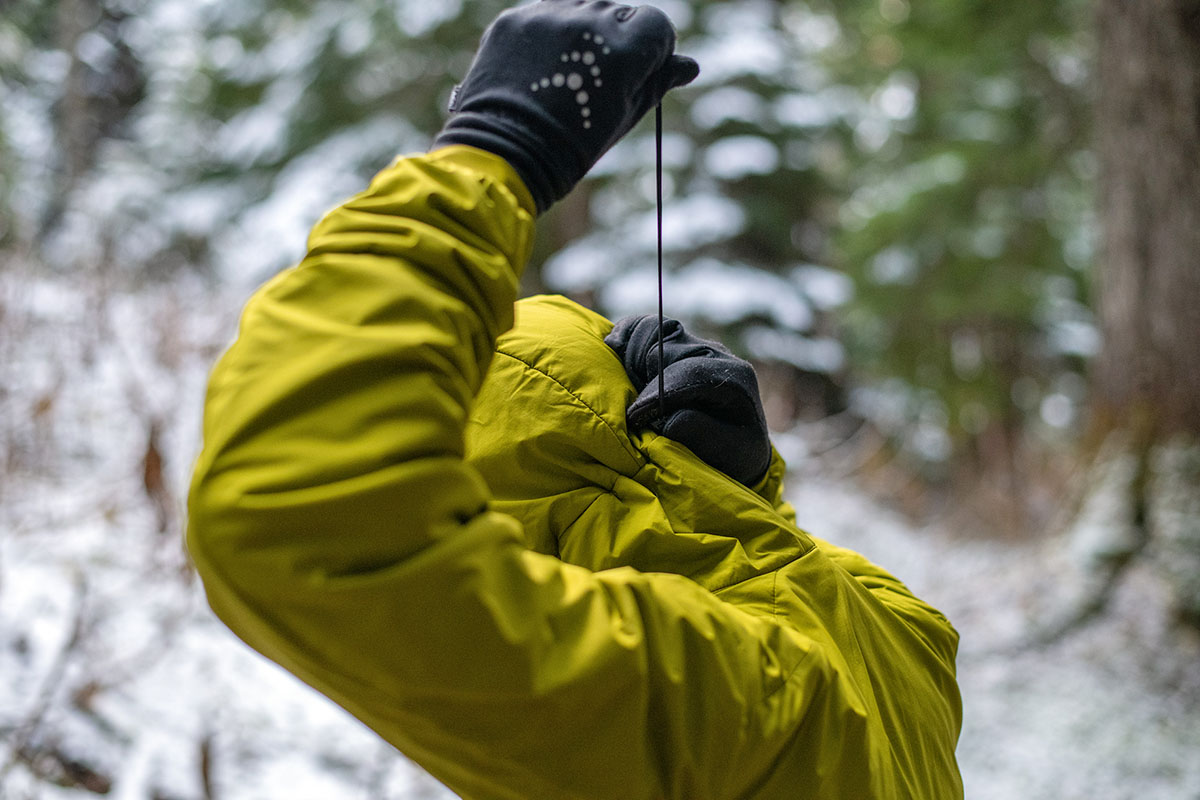
| Jacket | Price | Weight | Insulation | Fabric | Packable |
|---|---|---|---|---|---|
| Arc’teryx Atom Hoody | $300 | 13.1 oz. | Coreloft Compact (60g) | 20D | No |
| Patagonia Nano-Air Hoody | $329 | 14.1 oz. | FullRange (60g) | 30D | Yes |
| Patagonia Nano Puff Hoody | $289 | 12.8 oz. | PrimaLoft Gold Eco (60g) | 30D | Yes |
| The North Face ThermoBall Eco | $250 | 15.2 oz. | ThermoBall Eco | 20D | Yes |
| Arc'teryx Atom Heavyweight | $350 | 1 lb. 0.8 oz. | Coreloft (120g, 80g, & 60g) | 30D | No |
| Arc'teryx Proton Hoody | $350 | 14.1 oz. | Coreloft Compact (80g & 60g) | 20D | No |
We consider the Arc’teryx Atom to be the premier all-around synthetic on the market (it currently holds the top spot in our round-up), but another very popular option is Patagonia’s Nano-Air. The biggest difference here is breathability: The Patagonia uses FullRange insulation that runs cooler than Coreloft Compact during activity, plus it has a thicker yet more air-permeable 30D shell fabric. It also packs down into its own chest pocket for storage. On the flip side, the Arc’teryx checks in an ounce lighter, offers better weather protection and a little more warmth, and boasts the brand’s class-leading fit and finish that can’t be topped. In the end, these are two of the best synthetic jackets on the market, and choosing between them will likely come down to preferences on breathability, fit (the Patagonia has a more accommodating “regular” cut), and price (the Arc’teryx will save you $29).
A more casual option from Patagonia is the ubiquitous Nano Puff. This jacket uses 60g PrimaLoft Gold Eco and has a similar 20D shell as the Arc’teryx, but the boxy cut and lack of breathability make it more of an everyday piece. The stretchy side panels on the Atom provide better mobility than the Nano Puff and help in staying cool while on the go. All in all, we prefer the comfort and versatility of the Atom, especially given the minimal ($11) price difference. But the roomier fit of the Nano Puff may give it the edge for some people compared to the more athletic cut of the Atom, plus it’s better for layering and blocking wind.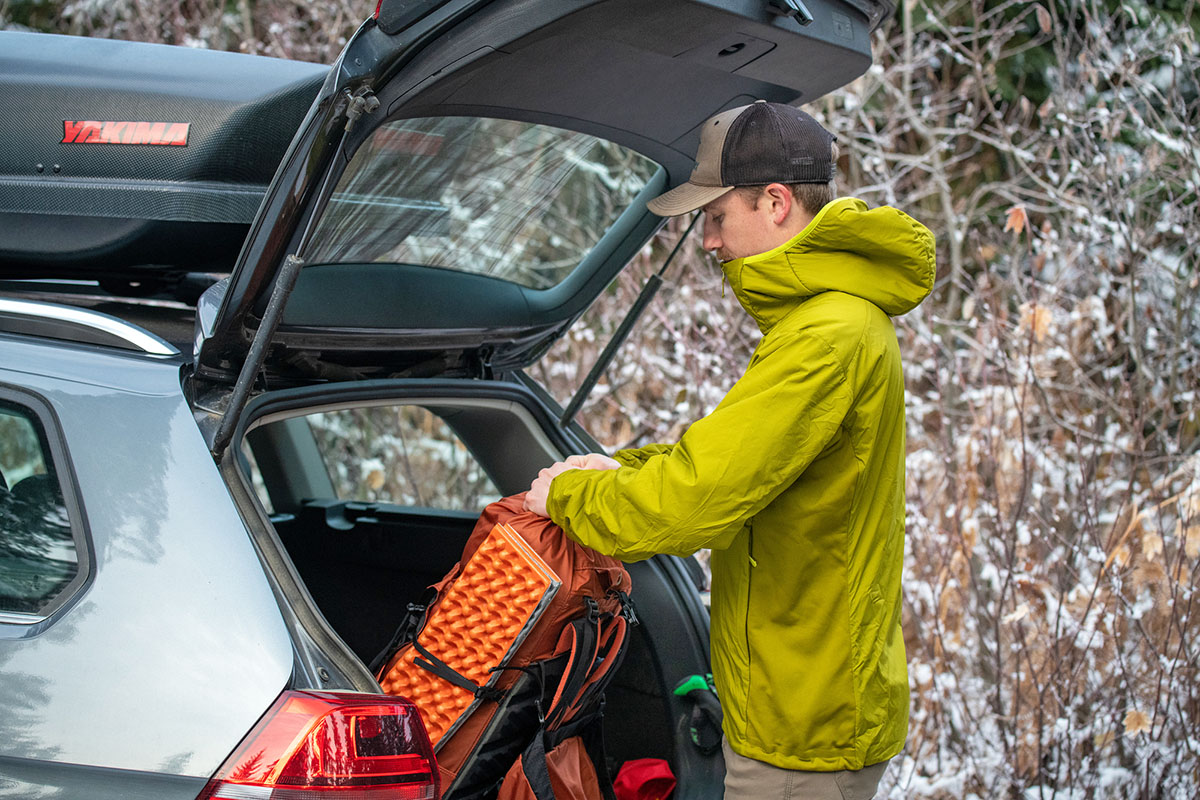
Another option to consider is The North Face’s ThermoBall: a down-mimicking piece stuffed with lofty ThermoBall Eco insulation. Recently updated with recycled materials and a retooled baffling pattern that traps heat more effectively, the ThermoBall gets the slight edge in warmth over the Atom along with better everyday appeal—it’s equally great for around-town use and as a midlayer for skiing. That said, the ThermoBall Eco is heavier at a listed 15.2 ounces, less breathable with a smooth interior that doesn’t wick moisture well, and fits on the boxier end of the spectrum. All things considered, the Atom is the cozier and better-looking option by a wide margin, and we prefer its trimmer cut for performance use.
Finally, within their own in-house lineup, Arc’teryx offers two intriguing alternatives: the Atom Heavyweight and Proton hoodies. As we touched on above, the Atom Heavyweight Hoody (formerly the Atom AR) is the warmest option in the Atom family with 120g Coreloft insulation in the body and less in the underarms (80g) and hood (60g). This translates to a sizable boost in warmth, and it’s also the more durable option with a 30D face fabric, but weight and price go up to 1 pound 0.8 ounces and $350. In the end, a final decision should come down to expected conditions: For shoulder-season trips and moderate days, the Atom is the more versatile piece; for true cold-weather outings, we’d step up to the Heavyweight (for more, see our Atom Heavyweight review).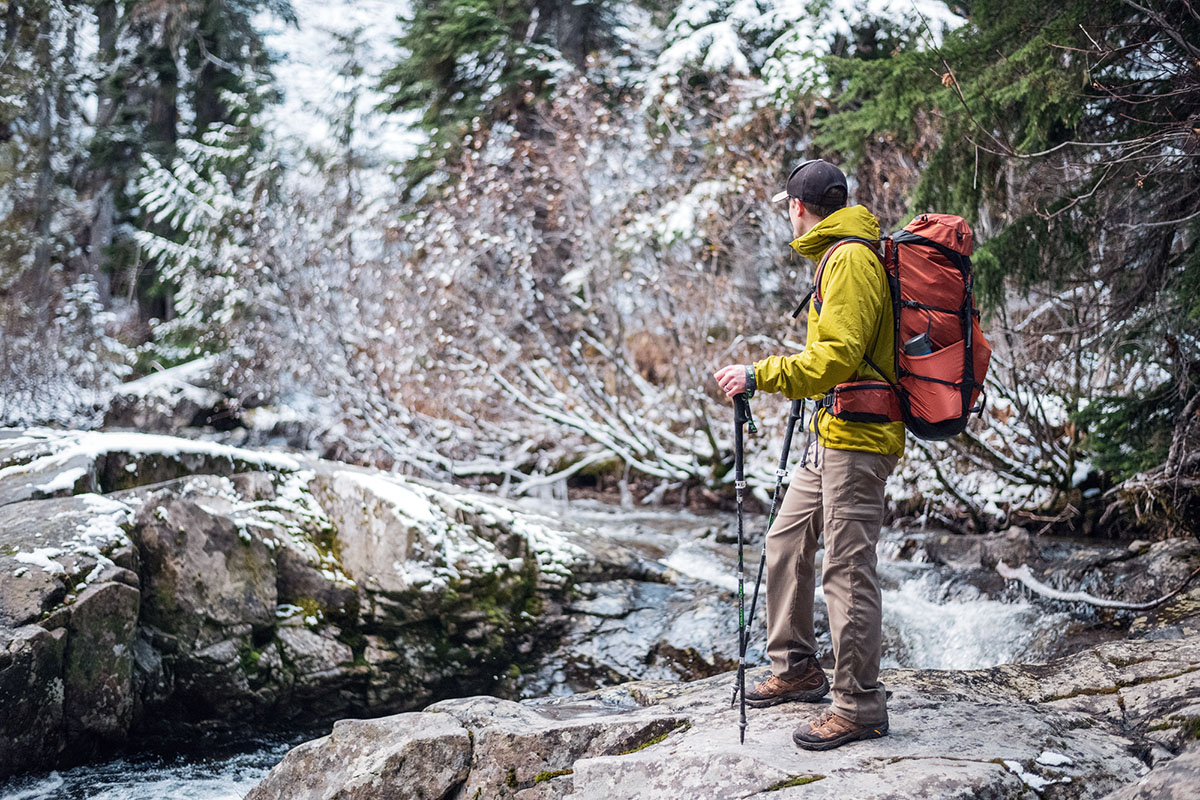
Last but not least is Arc’teryx’s backcountry-ready Proton Hoody, which was previously called the Proton LT. This model is designed to be more breathable than the Atom with an air-permeable shell and lining. Despite having more fill (80g Coreloft Compact in the body and 60g in the hood), this increased airflow translates to comparable warmth between the two designs. The Proton understandably gets the clear edge for high-output activities (we love it for cold days while backcountry skiing), but it makes compromises in styling (it’s far more technical than the Atom) and comfort (it can’t match the Atom’s sleeping bag-like coziness). As such, the Atom wins out as the more versatile of the two—and it’s $50 cheaper to boot—but both are undeniably high-quality options.
If you’re thinking about buying gear that we’ve reviewed on Switchback Travel, you can help support us in the process. Just click on any of the seller links above, and if you make a purchase, we receive a small percentage of the transaction. The cost of the product is the same to you but this helps us continue to test and write about outdoor gear. Thanks and we appreciate your support!
Depending on the seller, most products ship free in the United States on orders of $50 or more. International shipping availability and rates vary by seller. The pricing information on this page is updated hourly but we are not responsible for inaccuracies.